Paris’ grand boulevards, hidden parks and extraordinary galleries continue to delight time and time again.
Paris has given us so many gifts but for the traveller, the most precious legacy to come out the City of Lights is the concept of the flâneur. It has several translations; stroller, lounger, loaf but none of those properly describe the act and art of the flânerie. When I am in my beloved Paris my preferred translation of this mystical pastime is to saunter. It is as if Paris’ master renovator, Baron Haussmann, whose radical renovation of the city in the mid-1800s presented the world with a new concept of romance, knew exactly what humanity required – a city built for sauntering.
Admittedly, I’ve practised my fair share of travel snobbery eschewing the so-called tourist traps and spending many hours seeking out the so-called authentic but as the years have passed I’ve returned to Paris with a renewed awe for those epic locations where the city’s storied history is embedded in the stones of monumental symbology. The Champs-Elysees, the Avenue Victor Hugo, Avenue du President Wilson and of course the Boulevard Haussmann. I love to get lost down intriguing lanes with the best of them but every-so-often I have a deep need to return to the Paris of grand hotels, historic declarations and imposing architecture. Revisiting the trodded path allows me the exhilaration of reliving the very first time I set foot in the loveliest city in the world. And as an experienced flâneur and poet at heart, I see her afresh with every step I take.
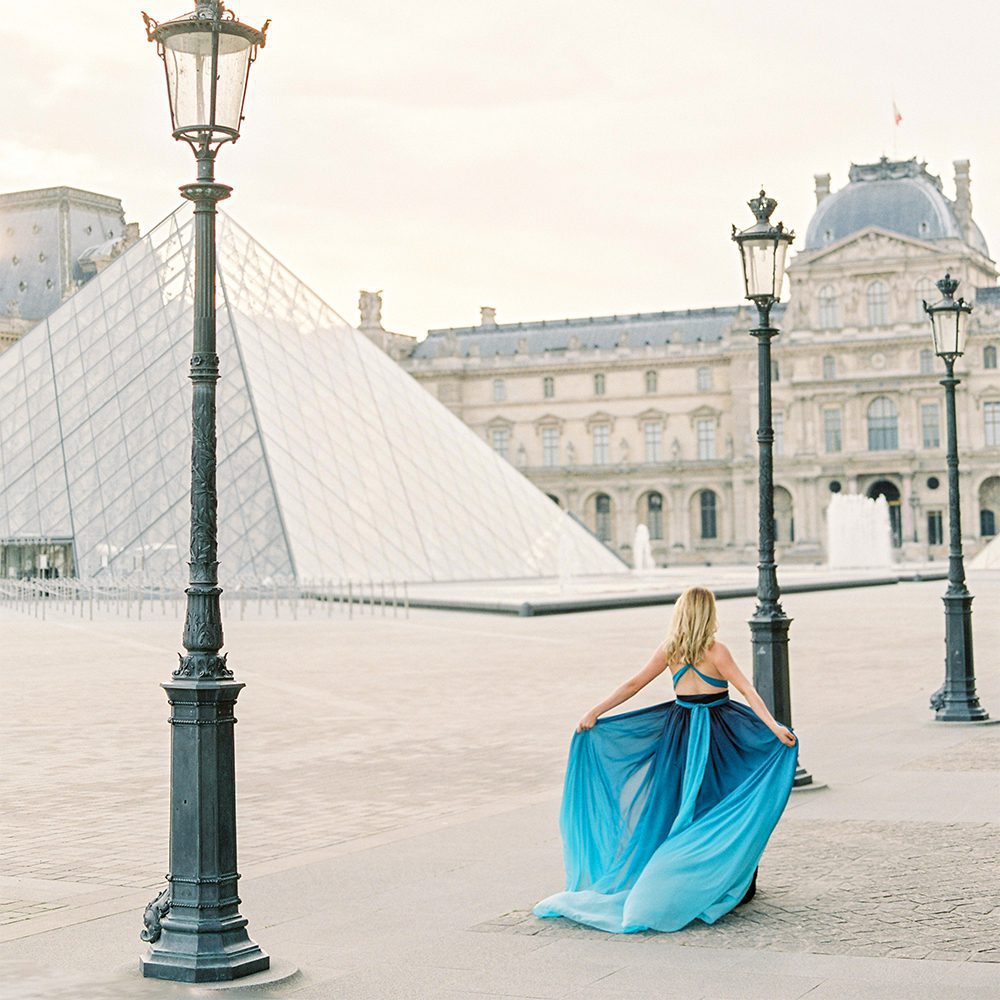
I.M Pei’s glass pyramid in the Louvre’s forecourt is Instagram heaven, photo by Analui
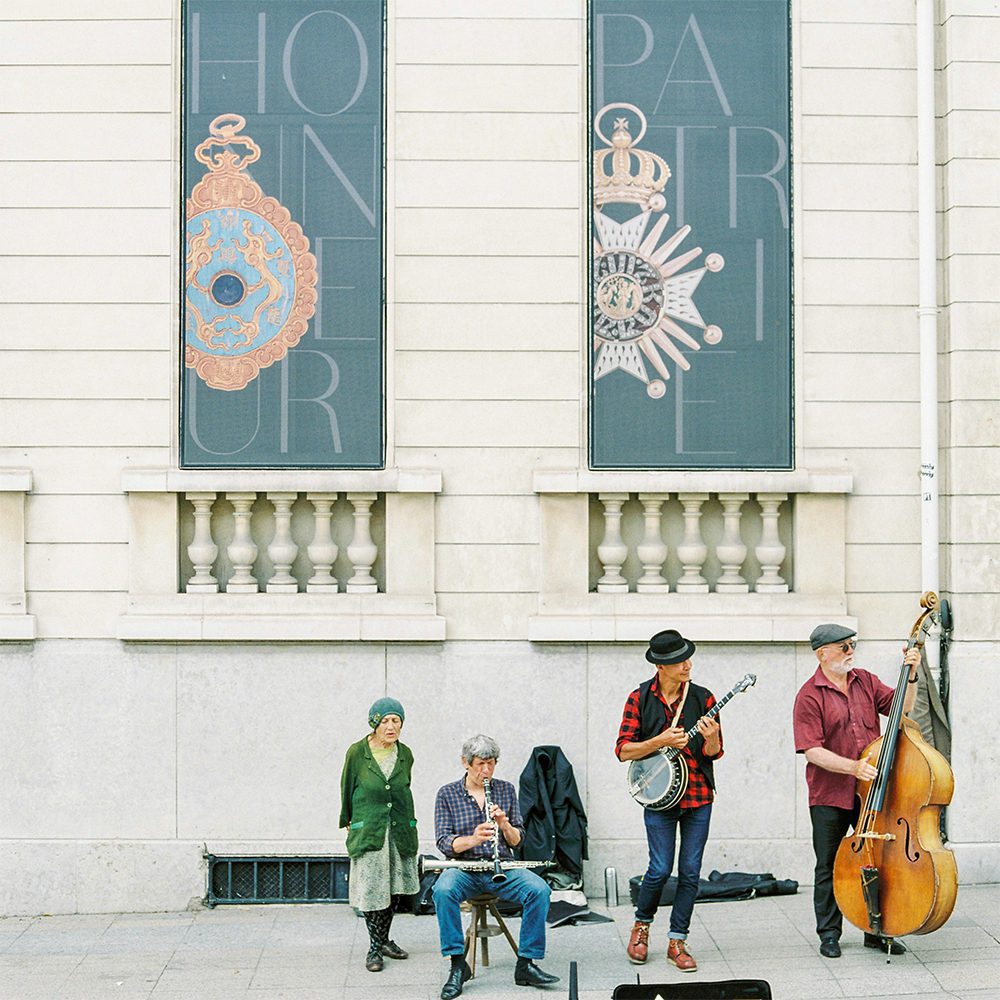
Street musicians channelling the best of French Jazz, photo by Analui
Parisians don’t really do breakfast but that doesn’t phase me. I don’t come to Paris to be a Parisian, I come to watch them. La Galerie at the Hotel Plaza Athénée is the epitome of how I want my Paris mornings to be. To sit in a velvet chair at a window overlooking the courtyard and bite down on one of Angelo Musa’s impossibly sublime pastries is an experience beyond imagination. The light glints off the chandeliers, hushed voices gossip, newspapers rustle and the anticipation of what the day might bring it positively electrifying.
The Hotel Plaza Athénée is the physical and spiritual home of one of the world’s greatest chefs. Alain Ducasse deserves every accolade and award that has been bestowed on him. Over the years he has repeatedly recreated what haute cuisine truly means. His menu has transformed into a beacon of sustainability, the exquisite flavours of which are matched only by the incomparable beauty of the hotel itself. It’s an icon, an emblem, a point of national pride especially if you manage to nab the Eiffel Suite. If the flânerie were to be immortalised in architecture it would have to be the Tour Eiffel, a structure whose only purpose is to exist as a beautiful monument to human endeavour. Its steely angles fill every window of the suite’s living room, a reminder of the futility of productivity and a push to hit the streets. Leave the unpacking to the butler and make your way to the myriad boutiques and flagship stores along the iconic Avenue Montaigne.
Before the Louvre became the world’s most famous museum it was a Royal Palace and while the halls lined with the work of history’s most illustrious artists beckon it’s the architecture that has me going back again and again. I’ll linger for a while in front of some of my favourite paintings because the galleries offer some of the most delicious people-watching opportunities but the opulence of the Second Empire soon has me headed to the exhibits of Napoleon III’s apartments which are best accessed by the impressive Lefuel staircase.
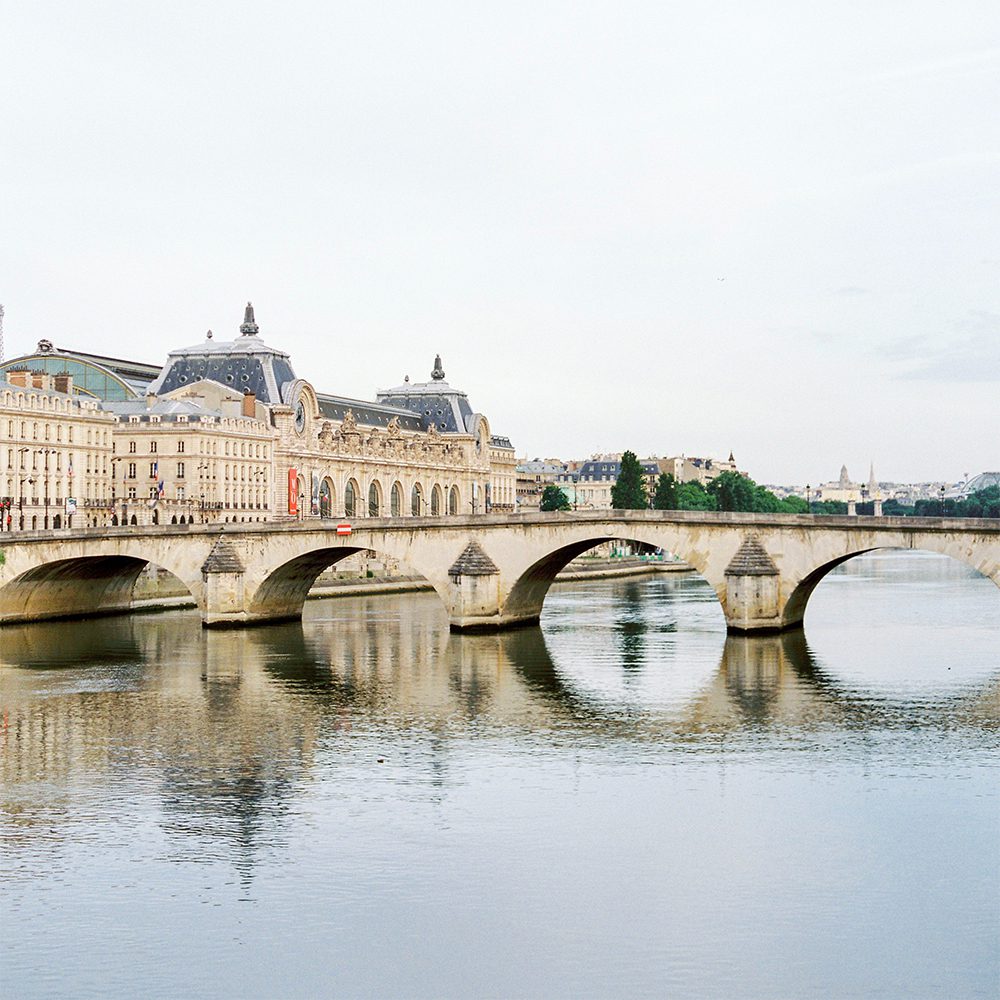
Bronze lions stand guard at the entrance to the Louvre, photo by Analui
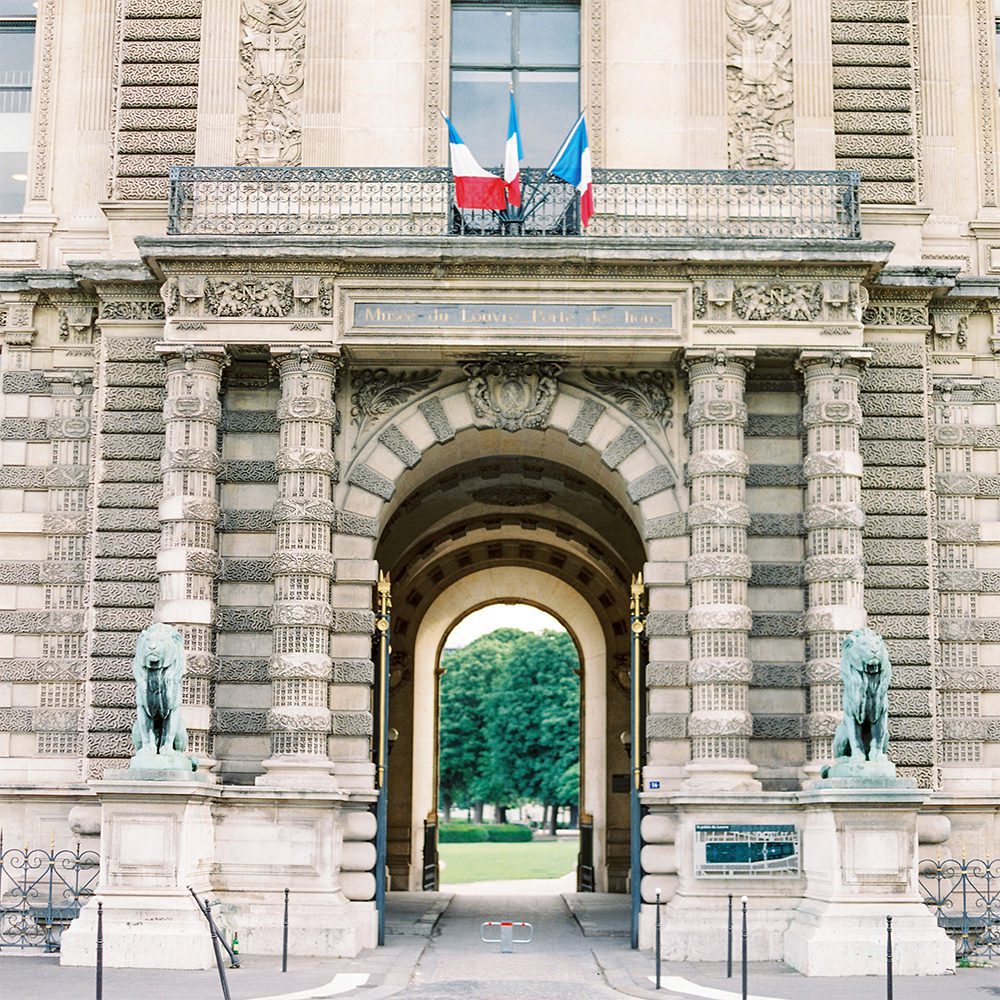
The Louvre with the Pont Royal in the foreground, photo by Analui
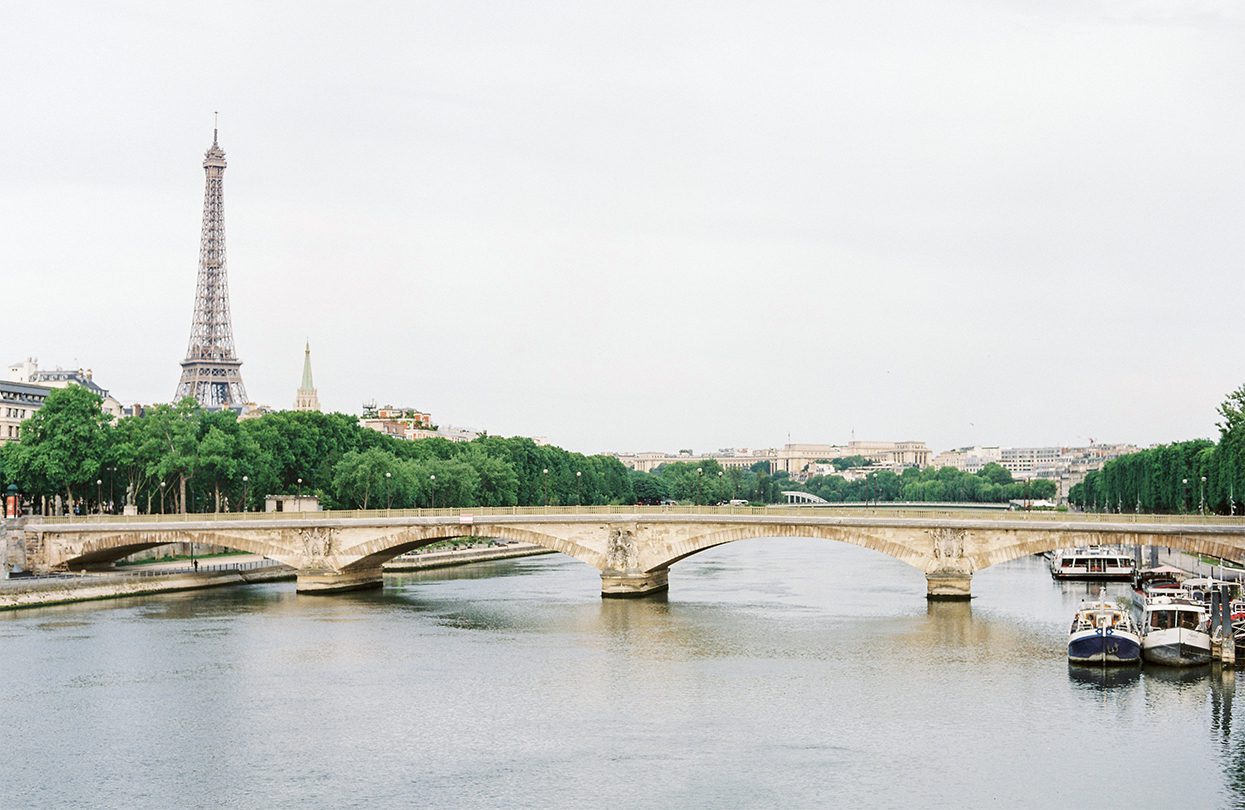
The Tour Eiffel rises behind the Pont d’Iéna, photo by Analui
Louis-Napoléon Bonaparte was the first Napoléon’s nephew (and also his step-grandson, royals are like that). He entertained luminaries in these lavish rooms with his beautiful wife Eugenie de Montijo whose portrait hangs in the parlour overlooking deep crimson upholstery, gilt mirrors and lavish knick-knacks. I allow myself a moment’s reverie to imagine taking tea and petit fours with the Empress amongst such over-the-top luxury.
Crossing over the Seine along the Pont des Arts once famous for the millions of now removed “love-locks” attached to the railings I pause to take in the glow of the Paris skyline reflecting across the river. The Tour Eiffel peeks out over the rooftops and as I turn my heart skips a beat to note that the spire of Notre Dame is no longer visible. Rallying against melancholy to think of that loss I head towards the Hotel Lutetia in one of my favouriteneighbourhoods, Saint-Germain-des-Prés where I take a well-earned seat at Bar Joséphine.
The flâneur knows when its time to take things indoors and within the Belle-Époque sumptuousness of the bar I contemplate the clientele with increasing interest wondering how they may have seemed to the many artists, writers and musicians that have called the Lutetia home. James Joyce wrote part of Ulysses here, which Hemmingway occasionally edited, no doubt accompanied by a cocktail. Picasso, Matisse, Becket, Malraux, Saint-Exupéry and Gide have all graced the art nouveau halls with their genius, as did Josephine Baker and later Serge Gainsbourg. Amongst such brilliant company I contemplate the way hotels can become emblematic of a city and make a note to read Pierre Assouline’s novel Lutetia, set in the famed hotel and also vowing to return for Chef Benjamin Brial’s magnificent dinner at the Restaurant Le Saint-Germain.
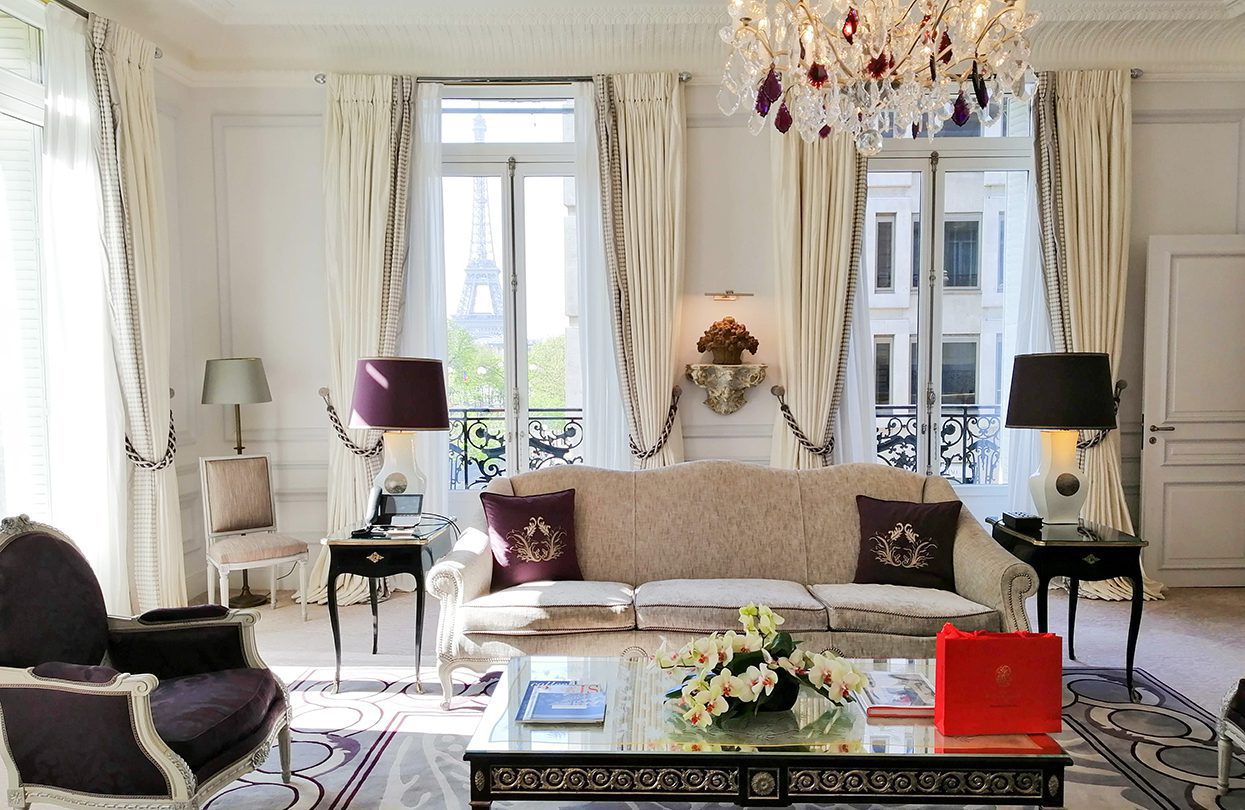
The Eiffel Suite at Hôtel Plaza Athénée
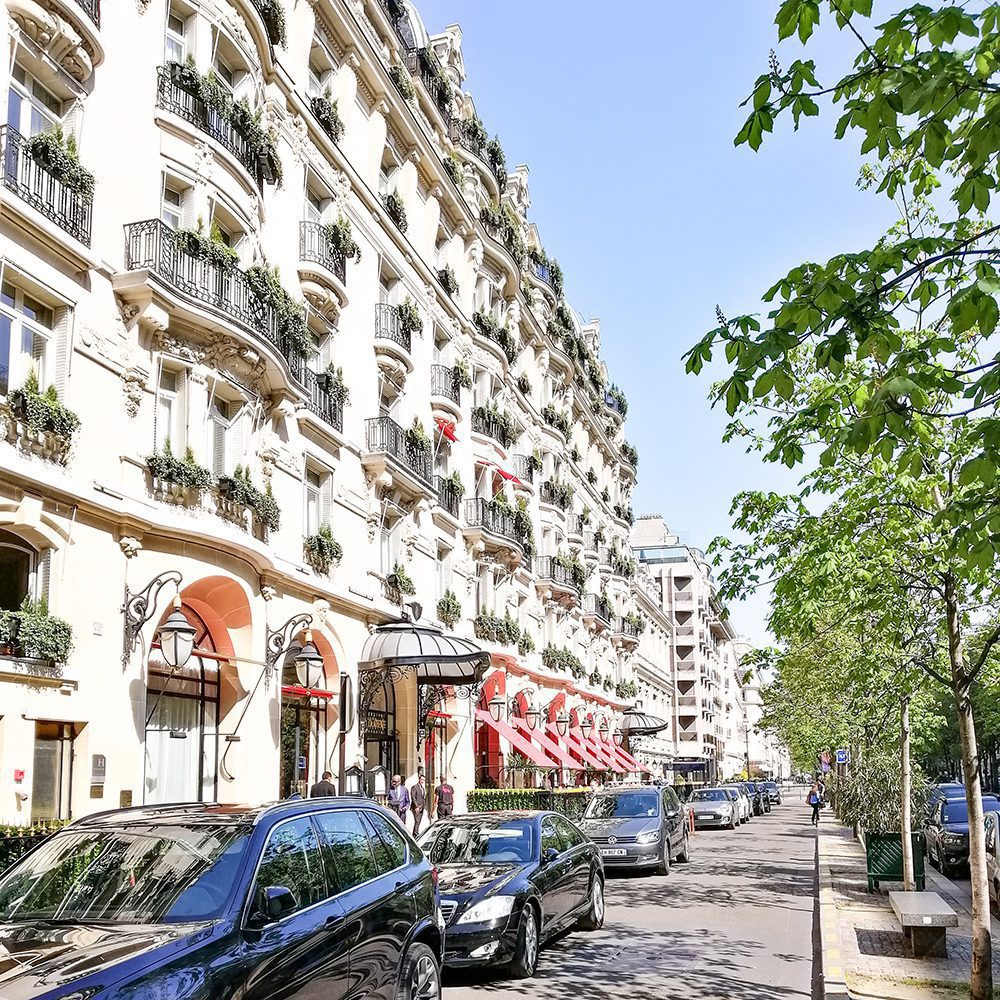
Plaza Athénée Façade
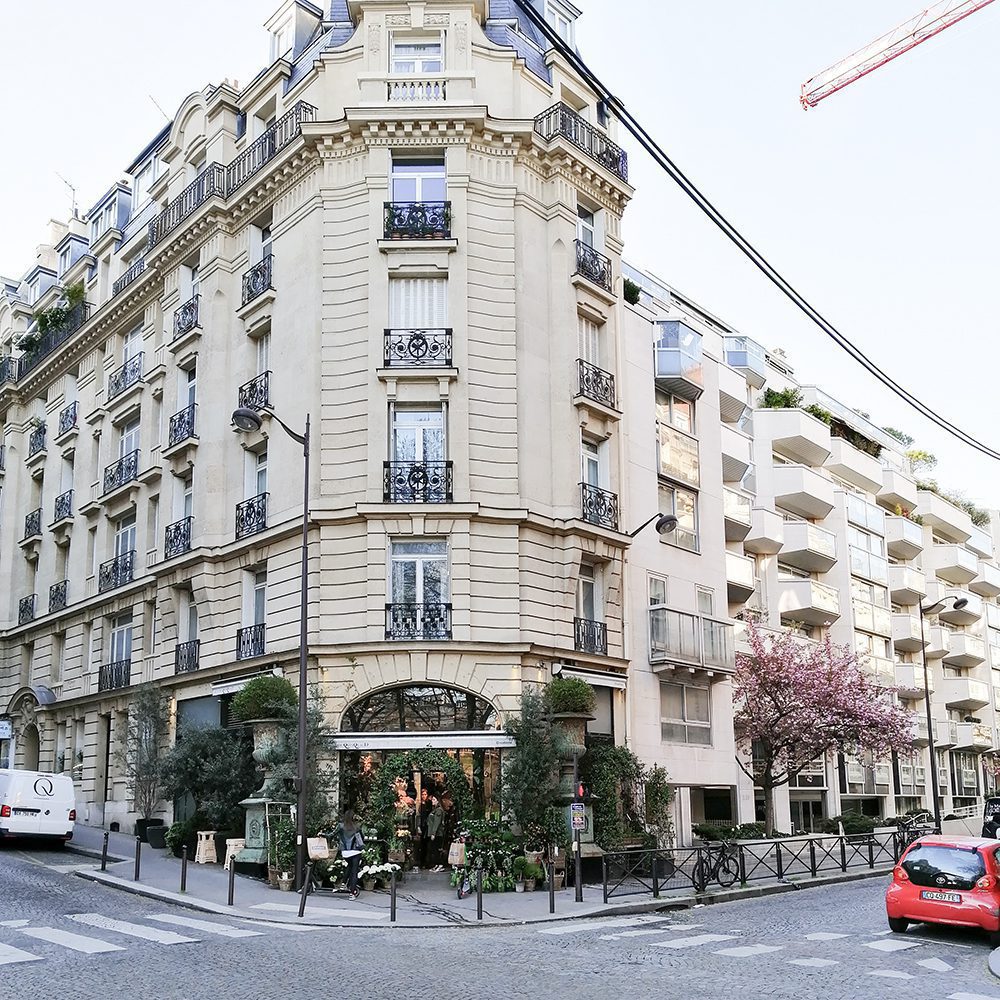
A flower shop in central Paris filled with exotic flowers
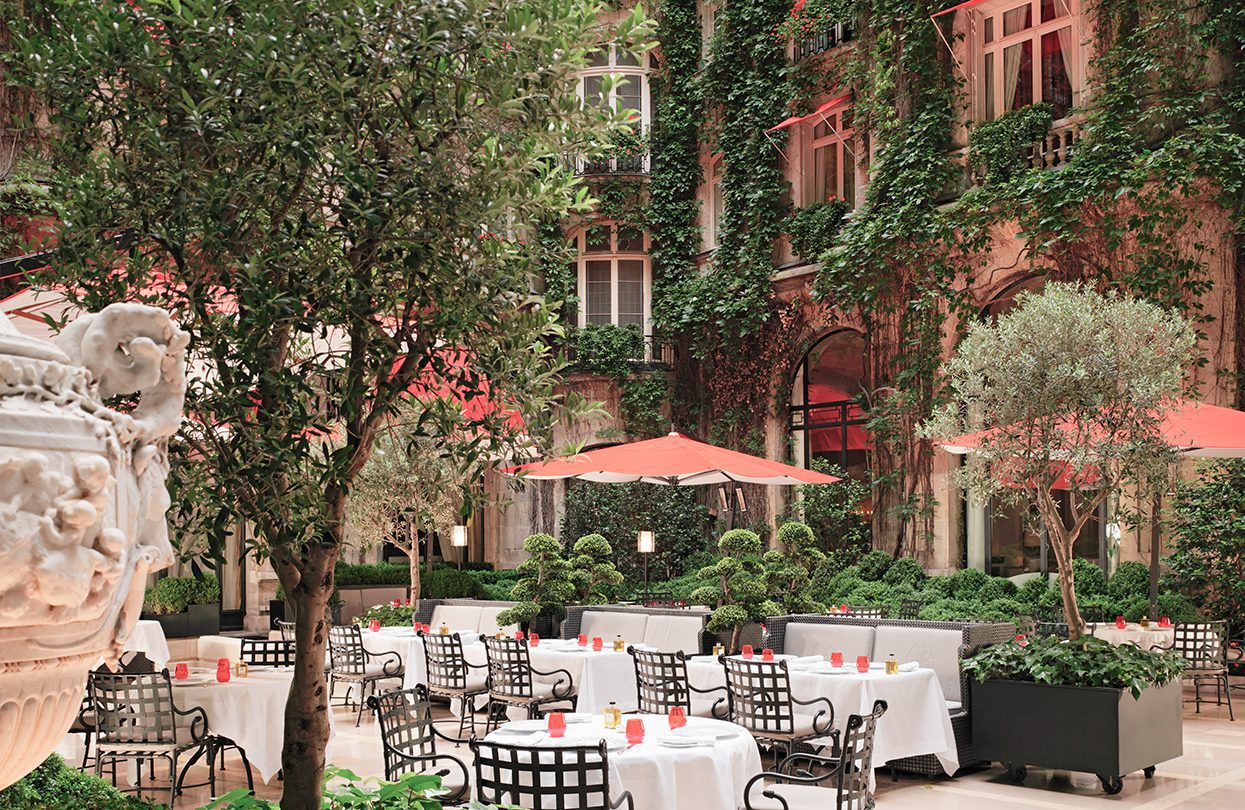
The courtyard at the Hotel Plaza Athénée, La Cour Jardin, a haven of peace in the busy city
As the City of Lights descends into the romance of twilight I head back to my hotel in anticipation of an evening of poetry followed by dinner. It’s difficult to imagine there are any quiet streets near the Champs-Elysees but the red lacquered door of La Réserve opens to the gorgeous tree-lined Avenue Gabriel. This hotel feels more like a private home with its limited number of suites and rooms. It’s lavish in the way all good hotels should be; silk wall coverings, velvet curtains, brocade upholstery and staff who seem to intuit your needs and yet it contains a familiarity you only find at home.
Poetry and Paris have long been intertwined and on Thursday evenings, the secluded book-lined library at La Réserve is host to intimate gatherings in honour of the city’s most celebrated poets. To hear verse spoken out loud opens a gateway to a deeper understanding and respect for literature. The evening starts with champagne and mignardises as journalist and writer Olivier Barrot presents a short biography of the poet before reciting some poems. Dinner for 14 follows at La Pagode de Cos, which is headed up by two Michelin-star chef Jérôme Banctel. Over a menu inspired by the classics of Bordeaux the conversation flitters between literature, art and gossip all expertly moderated by the wonderful Olivier.
In the morning, I semi-reluctantly skip breakfast at the hotel and head to 86Champs, the sparkling collaboration between L’Occitaneen Provence and king of the macaron Pierre Hermé. I settled in at the bar and order an almond milk cappuccino with a viennoiserie and can barely resist the Instagram moment when the coffee is set before me, its creamy froth marked by a perfectly dusted pink logo. I drool over the Isaphan – Hermé’s signature creation named for the pale pink rose and flavoured with lychee, rose and raspberry and instead settle on some jewel-coloured macarons as perfect take-home gifts.
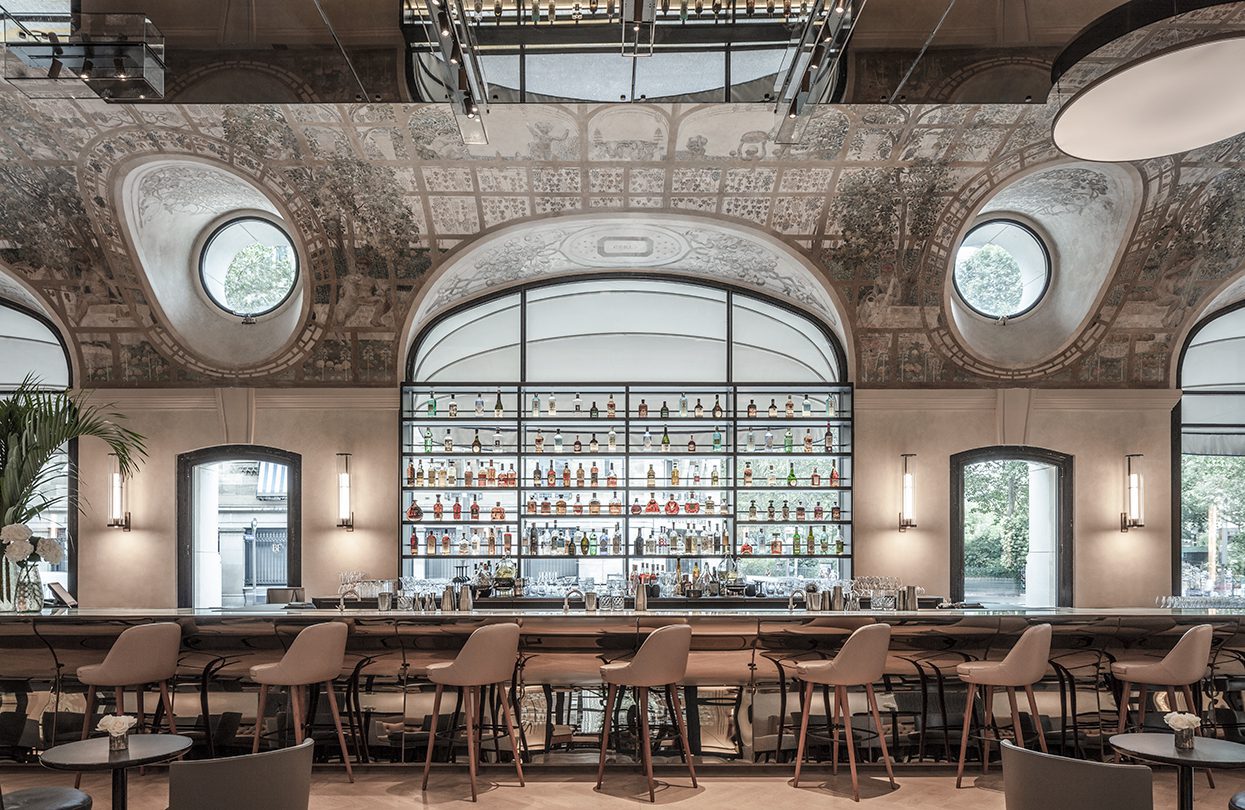
The stunning Bar Joséphine at Hotel Lutetia
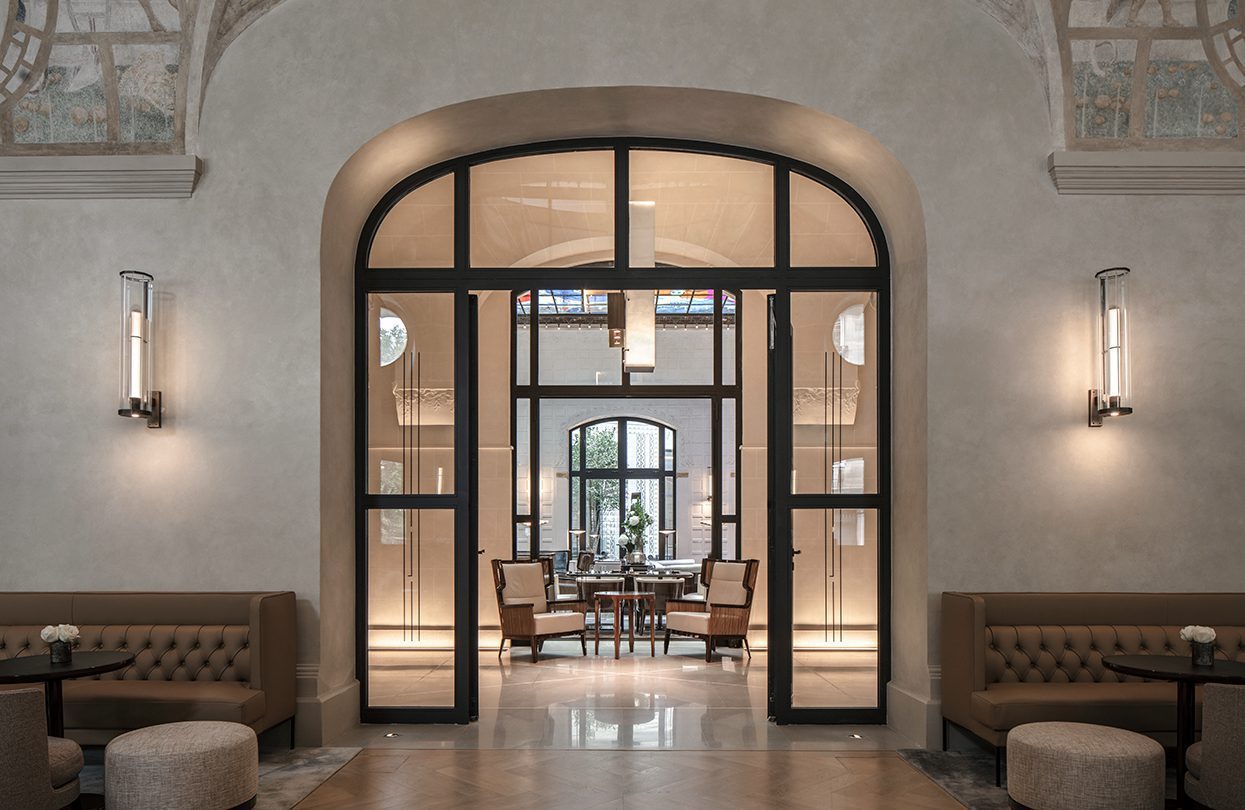
Lobby view from Bar Joséphine
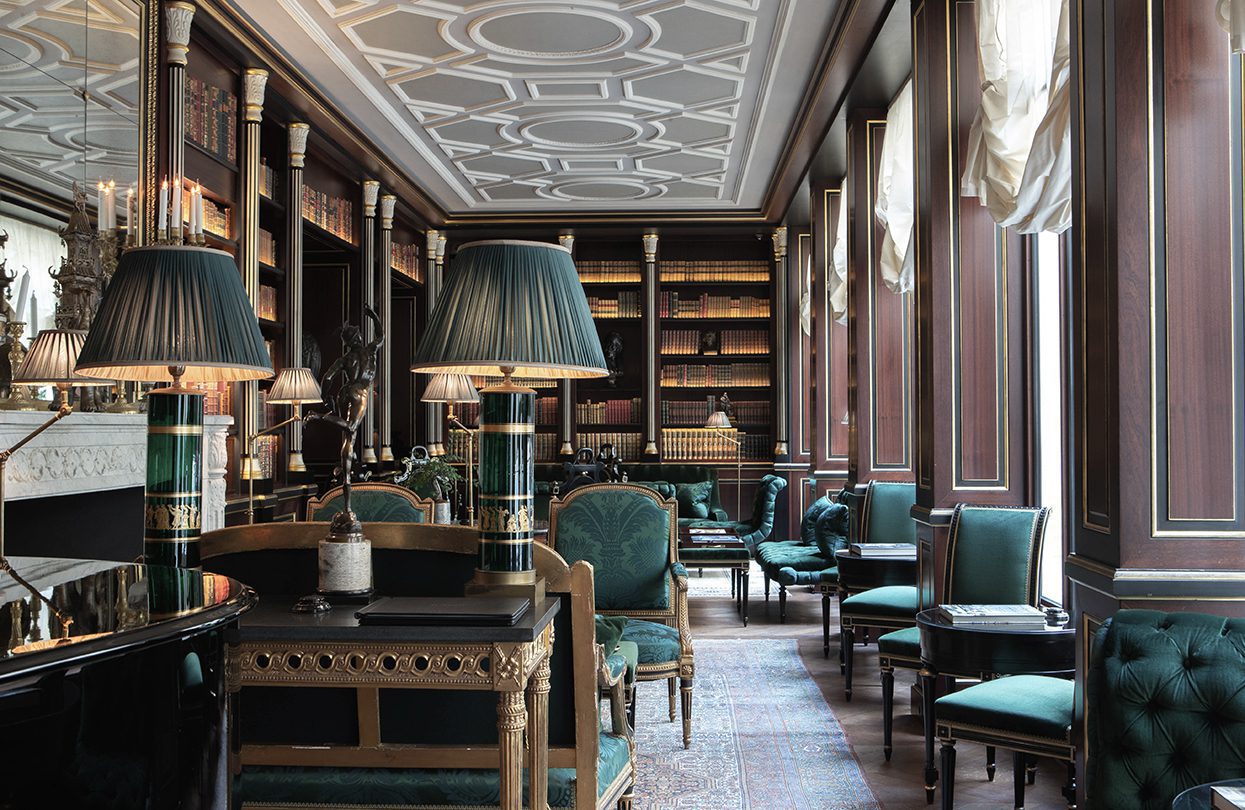
The library at La Réserve
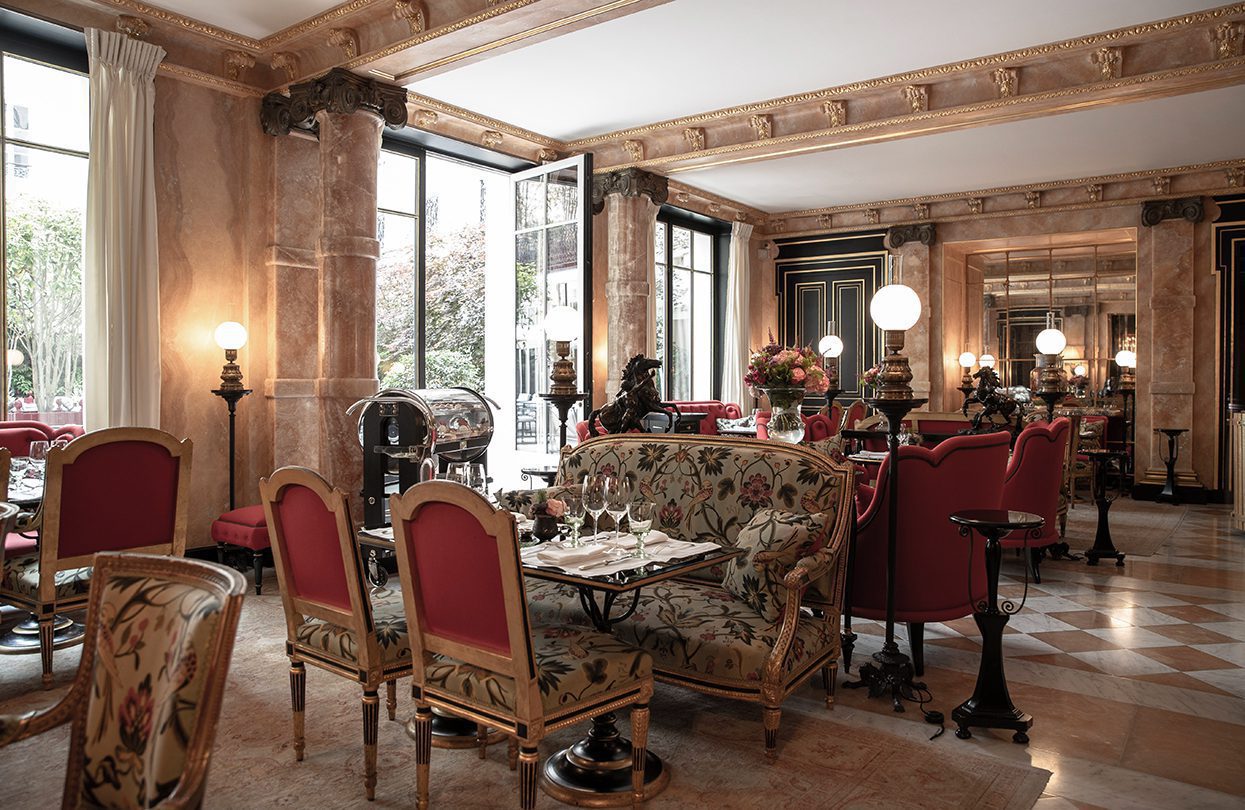
Dining room of La Pagode de Cos at La Réserve
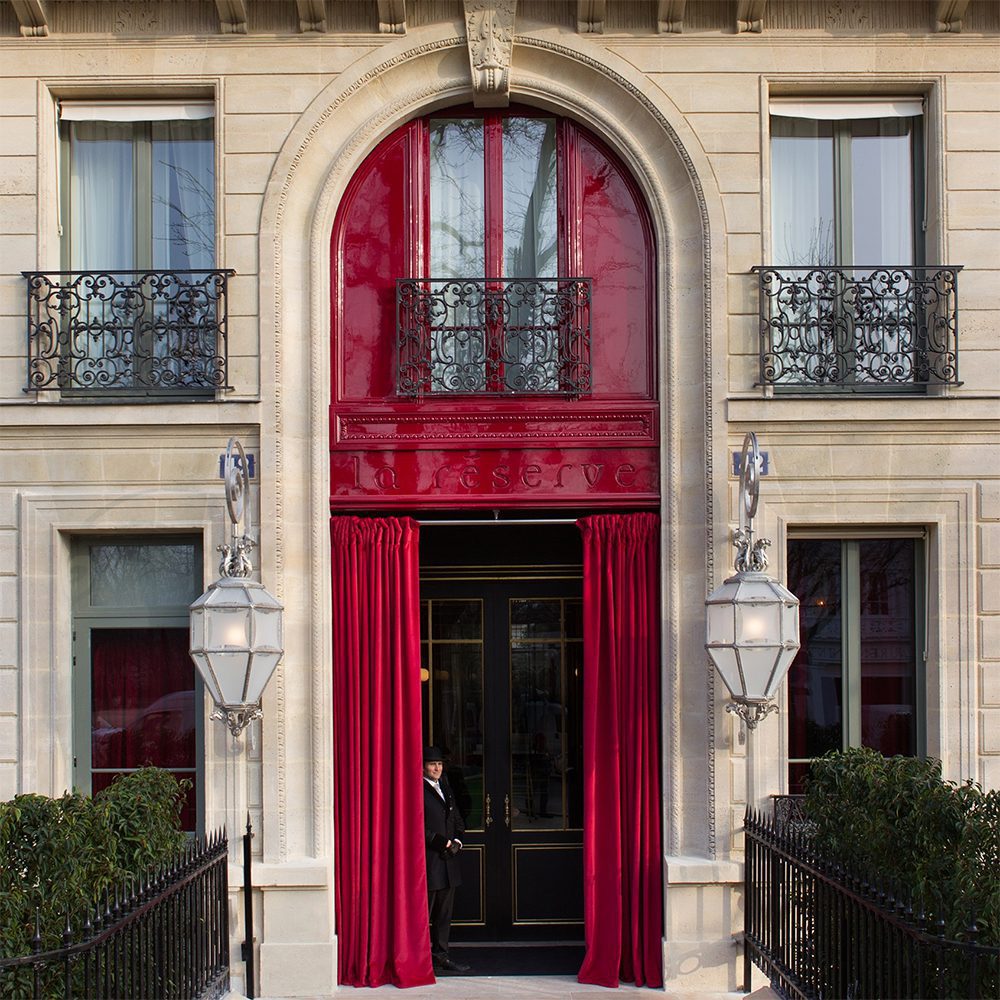
The red-lacquered door of La Réserve
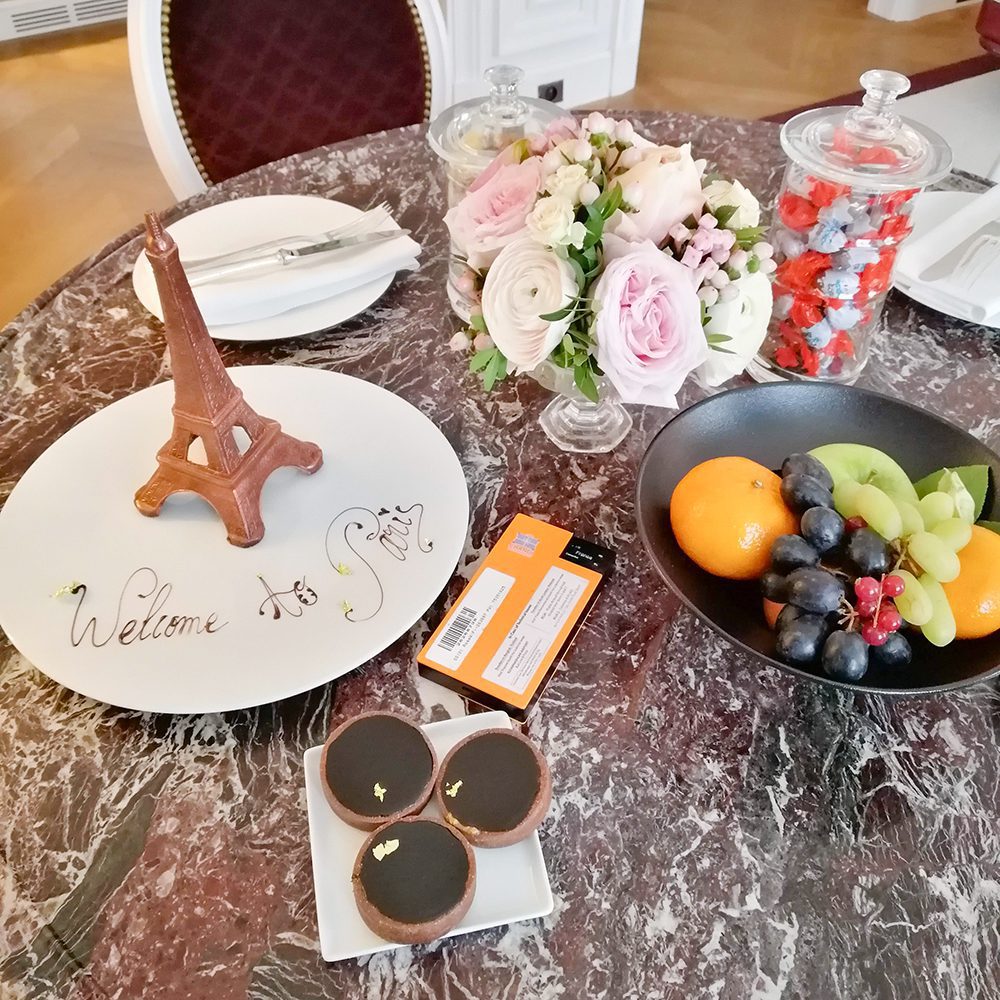
A sumptuous welcome at La Réserve
Having over-indulged I happily return to the flânerie and start strolling towards the Arc de Triomphe gazing up at the Haussmann façades and fantasising about all the weird and wonderful people who have lived in these magnificent homes over the centuries. By the time I get to the Avenue Victor Hugo I’m humming Debussy, thinking about Benjamin Franklin and hoping to bump into Lenny Kravitz, all of whom have lived in this area. Realising that Lenny is probably not going to materialise anytime soon I jump into a cab to go visit one of my other heroes.
The MuséeMarmottan Monet sits between the Bois de Boulogne and the delightful Jardin de Ranelagh with its wooden carousel, puppet shows and towering chestnut trees. Monet has always been a favourite and this gorgeous museum contains the largest collection of his work in the world. The permanent collection is outstanding including not only the Monets but also works from Degas, Manet, Sisley and Renoir among many others. It’s enchanting to spend the day lost among the brush strokes of these renegade artists. Twice a year a modern-day artist is invited to create a body of work inspired by the collection and I was lucky enough to see Gerard Fromanger’s response to Monet’s Impression, Soleil Levant, asking the question: how to paint a rising sun in 2019? The result is spectacular.
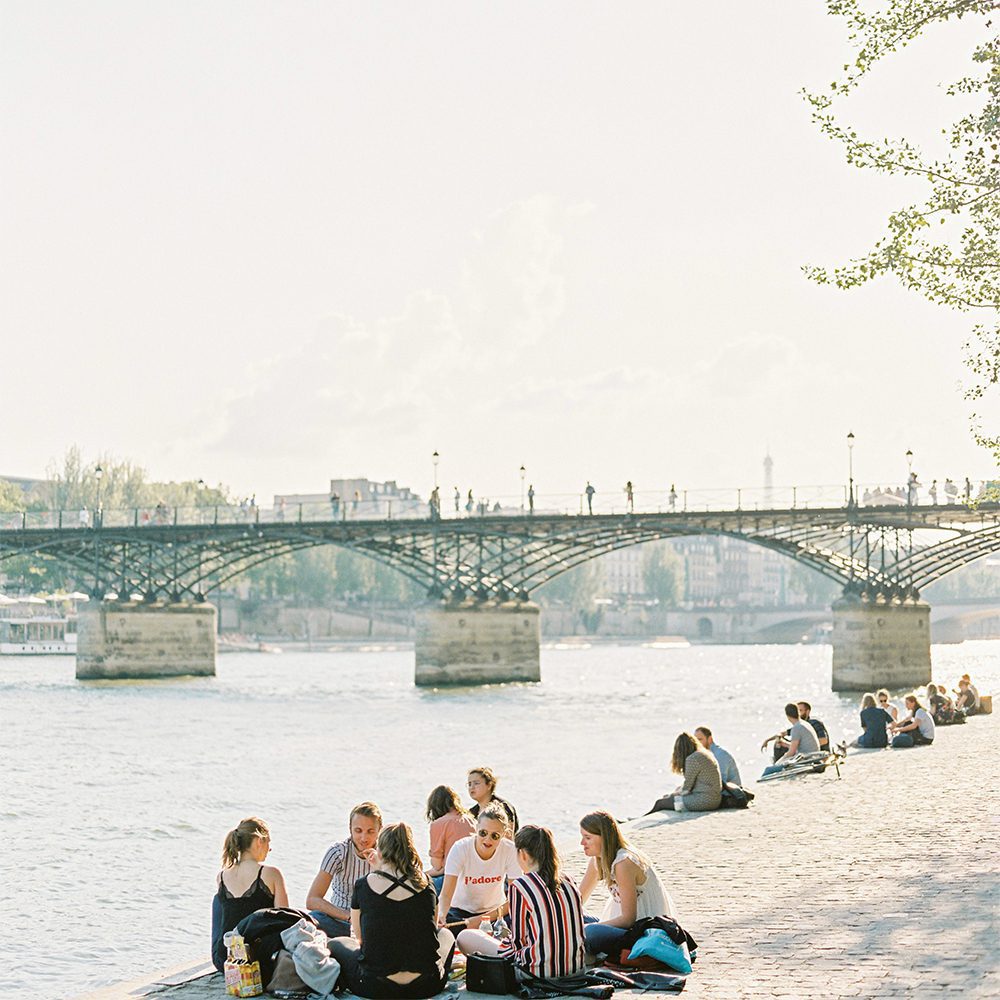
The promenades along the Seine are a popular hangout spot, photo by Analui
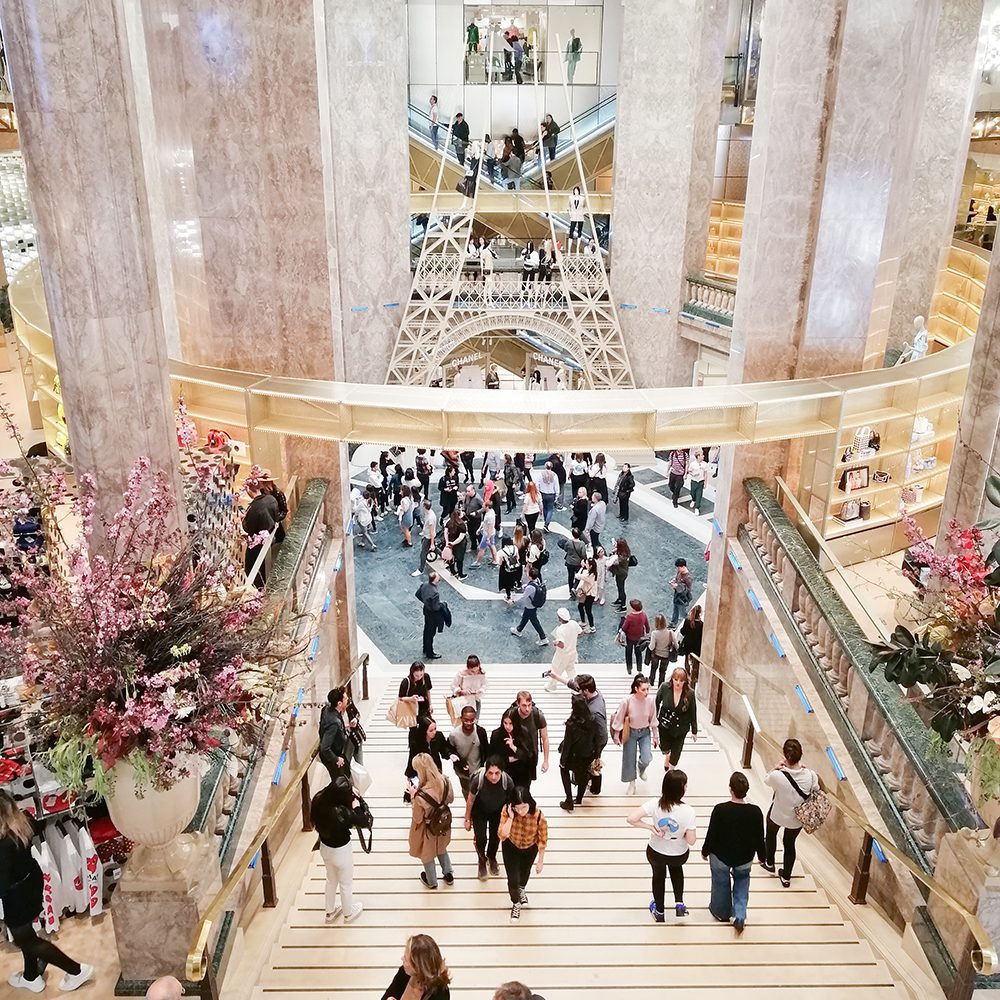
Shopping heaven at Galeries Lafayette Champs-Élysées
If there’s anything Paris takes seriously it’s art and lunch with a bit of pomp on the side. While waiting for friends to join me at the 3 Michelin-star Epicure at the Le Bristol hotel I spot an American diplomat with an entourage rushing in from a meeting at the Élysée Palace no doubt. There’s European Union politicians and lackeys all over the lobby as the irate diplomat bustles across the floor. On reaching the courtyard, assuming he’s out of sight, he crumbles into one of the elegant sofas and motions his team to at-ease. He did an Oscar-worthy job of posturing before the assembled politicos none of whom dare approach to wish the American a ‘good morning’. Noting that one of Trump’s junior lieutenants is not in a good mood they instead huddle towards the other side of the hotel, revaluating their negotiating positions for the day. It’s all appearances after all and oh-so Paris. Le Bristol always delivers excellent people watching.
On to lunch, however. This year marks 20 years of chef Eric Frechon’s reign at Epicure. The maestro has created a menu of his favourite dishes that includes caviar from Sologne, grilled Ile de France leeks served with tartar of Perle Blanche oysters and the famous Bresse farm hen. It’s enough to make me wish I had one of those ornate, old-fashioned keys that open the doors to the Royal suite so I could swoon onto a plush bed overlooking the flower-filled courtyard. Instead, I head to the Parc Monceau with its grand trees and quirky 18th-century folies. It’s a blissfully green escape right in the heart of Paris’ busiest district. Here I sit a while, watching Parisians walk their dogs, play with their children and take in the sunshine. Monet painted this park and I think back to the MuseéMarmottan and make a note to visit his Monceau paintings next time I’m at the Met in New York.
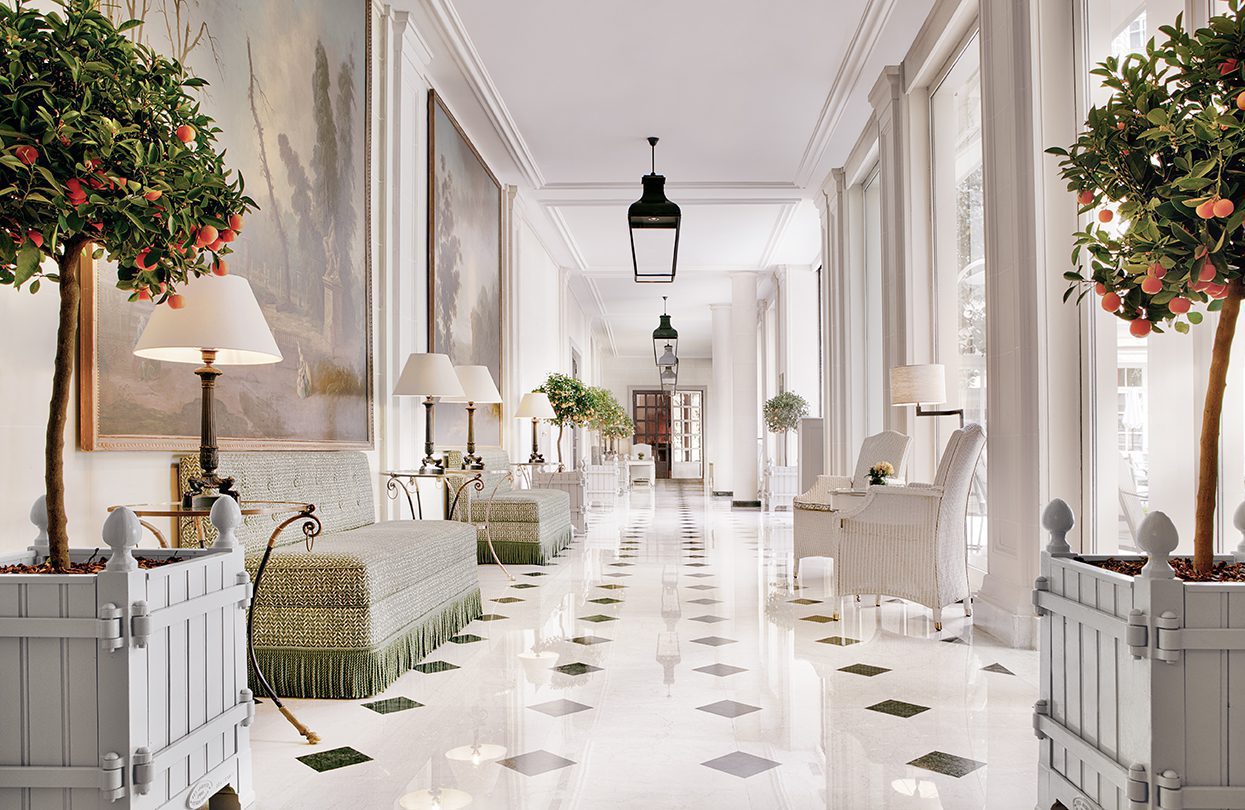
The sun-dappled colonnade of Le Bristol
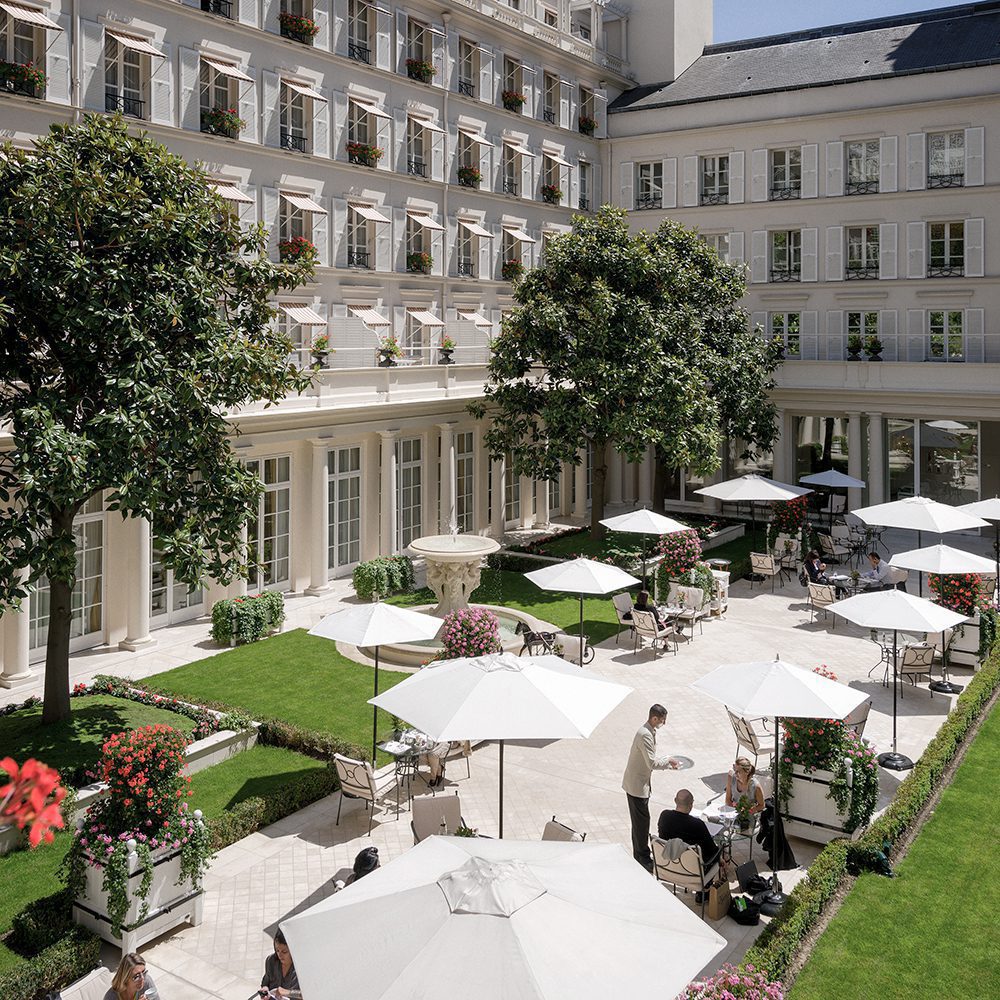
Le Jardin Français is a rare jewel in the heart of Paris – a place where guests can drink and dine amidst fresh greenery and fragrant roses
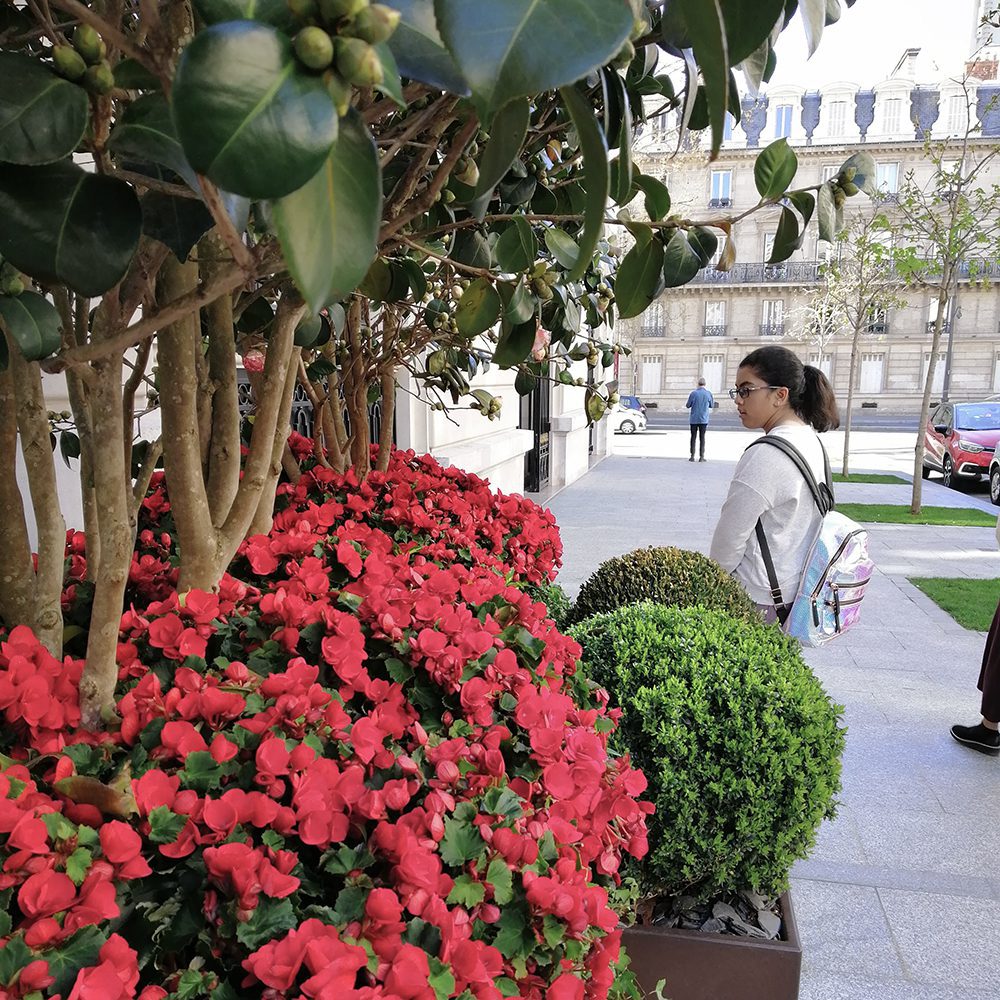
Paris is always in bloom, outside the Peninsula
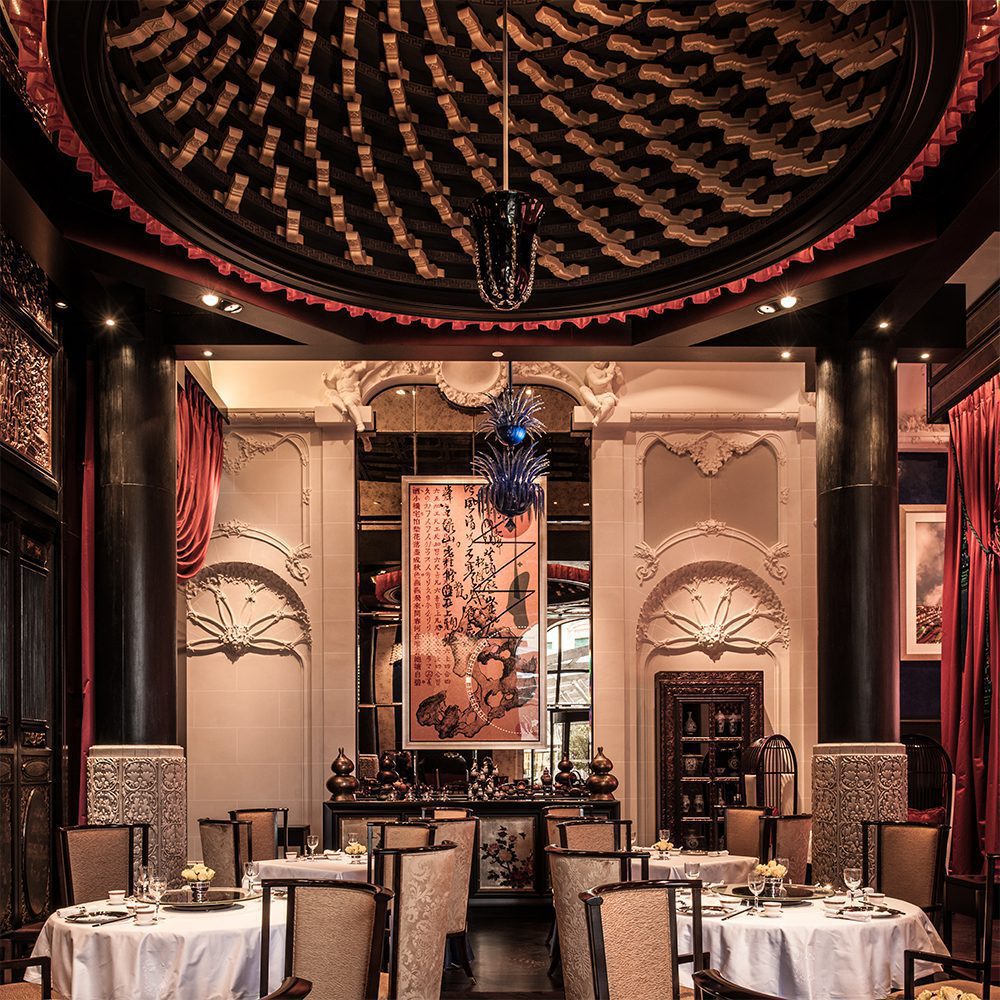
The opulent LiLi restaurant at the Penninsula Paris
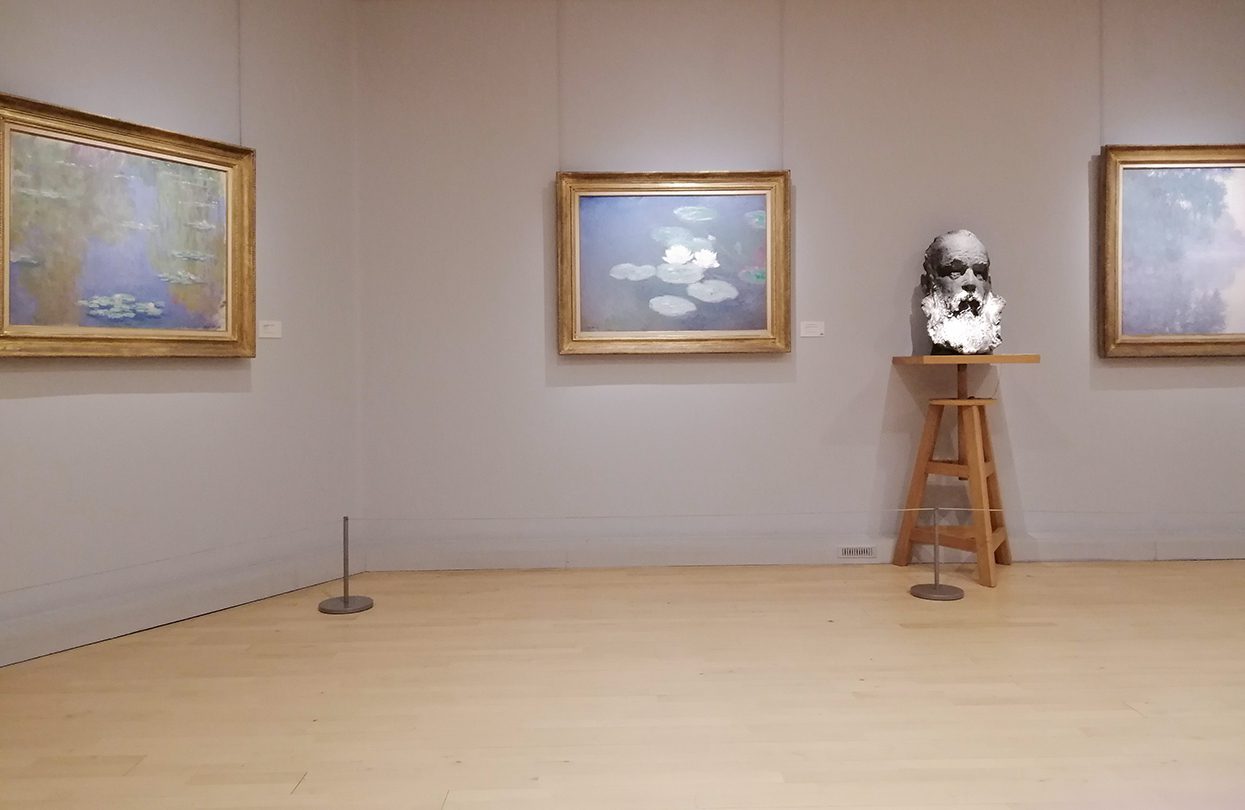
Monet’s masterpieces on display at Musée Marmottan Monet
My last days in Paris are spent at the Peninsula because despite my Francophile tendencies I just can’t skip a little Asian hospitality with a French twist at this divine hotel. I make a date with Dim Sum and Chinese tea at LiLi after which I retire to Le Rooftop for a nightcap and one last, longing look at the glittering city skyline. The Tour Eiffel glows in the distance and I wonder how many steps I’ve taken during this trip but than admonish myself because a true flâneur never focuses on the destination but always on the journey.
Charles Baudelaire immortalised the flâneur in his essay “The Painter of Modern Life”. For the casual observer or the disciplinarian or worse, the planner, the flânerie may appear to be an idle waste of time for aimless and unproductive people but for Baudelaire (and for me) there is nothing more joyous than “to be at the centre of the world, and yet to remain hidden from the world”. Indeed, looking back at the seemingly purposeless wandering I did along these grand boulevards and streets the poet’s words materialise in the memory of the buttery pastry of my morning croissant, the flip of a woman’s skirt, the woosh of a bicycle carrying an impossibly beautiful young man off into the traffic. As the nightcap’s warmth leads me to my bed I realise that I am Baudelaire’s flâneur, I am “the lover of life who makes the whole world his family.” www.visitparisregion.com ◼
Subscribe to the latest edition now by clicking here.
© This article was first published in Oct-Nov 2019 edition of World Travel Magazine.

